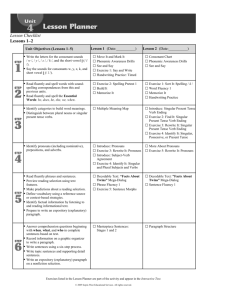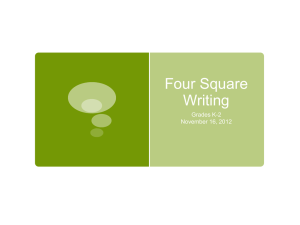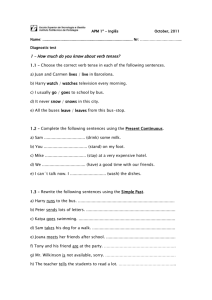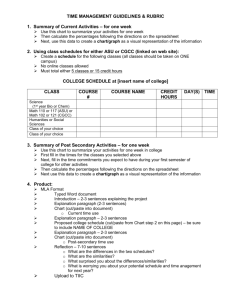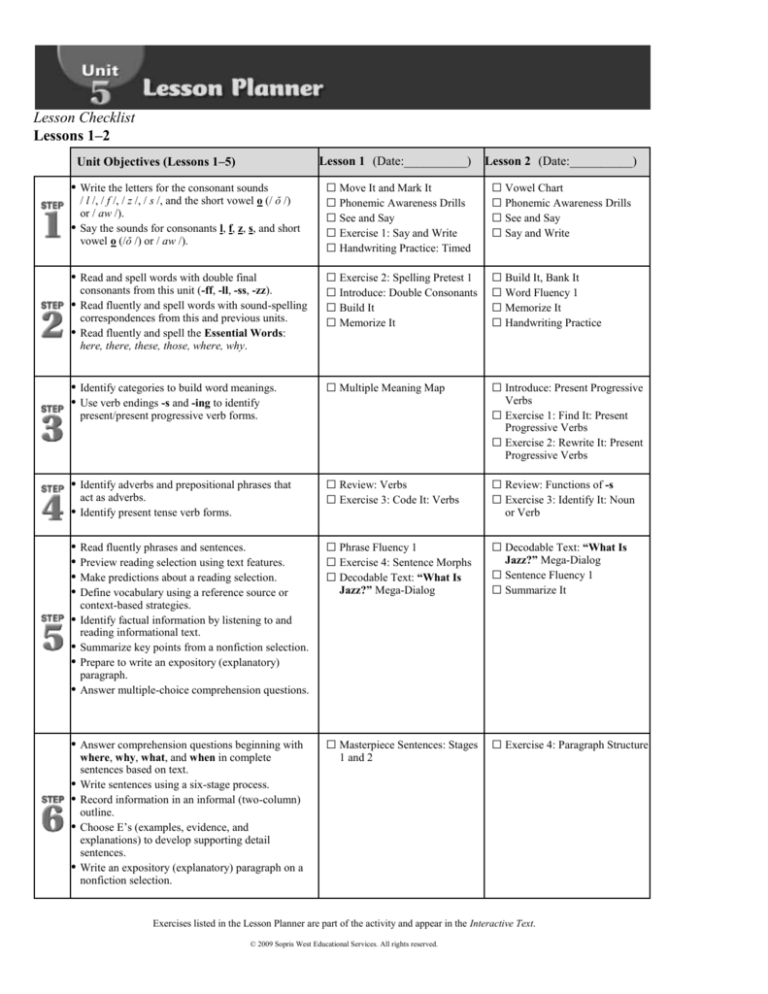
Lesson Checklist
Lessons 1–2
Unit Objectives (Lessons 1–5)
• Write the letters for the consonant sounds
•
/ l /, / f /, / z /, / s /, and the short vowel o (/ ŏ /)
or / aw /).
Say the sounds for consonants l, f, z, s, and short
vowel o (/ŏ /) or / aw /).
• Read and spell words with double final
•
•
consonants from this unit (-ff, -ll, -ss, -zz).
Read fluently and spell words with sound-spelling
correspondences from this and previous units.
Read fluently and spell the Essential Words:
here, there, these, those, where, why.
• Identify categories to build word meanings.
• Use verb endings -s and -ing to identify
Lesson 1 (Date:__________)
Lesson 2 (Date:__________)
□ Move It and Mark It
□ Phonemic Awareness Drills
□ See and Say
□ Exercise 1: Say and Write
□ Handwriting Practice: Timed
□ Vowel Chart
□ Phonemic Awareness Drills
□ See and Say
□ Say and Write
□ Exercise 2: Spelling Pretest 1
□ Introduce: Double Consonants
□ Build It
□ Memorize It
□ Build It, Bank It
□ Word Fluency 1
□ Memorize It
□ Handwriting Practice
□ Multiple Meaning Map
□ Introduce: Present Progressive
Verbs
□ Exercise 1: Find It: Present
present/present progressive verb forms.
Progressive Verbs
□ Exercise 2: Rewrite It: Present
Progressive Verbs
• Identify adverbs and prepositional phrases that
•
•
•
•
•
•
•
•
•
act as adverbs.
Identify present tense verb forms.
•
•
□ Review: Functions of -s
□ Exercise 3: Identify It: Noun
or Verb
Read fluently phrases and sentences.
Preview reading selection using text features.
Make predictions about a reading selection.
Define vocabulary using a reference source or
context-based strategies.
Identify factual information by listening to and
reading informational text.
Summarize key points from a nonfiction selection.
Prepare to write an expository (explanatory)
paragraph.
Answer multiple-choice comprehension questions.
• Answer comprehension questions beginning with
•
•
□ Review: Verbs
□ Exercise 3: Code It: Verbs
where, why, what, and when in complete
sentences based on text.
Write sentences using a six-stage process.
Record information in an informal (two-column)
outline.
Choose E’s (examples, evidence, and
explanations) to develop supporting detail
sentences.
Write an expository (explanatory) paragraph on a
nonfiction selection.
□ Phrase Fluency 1
□ Exercise 4: Sentence Morphs
□ Decodable Text: “What Is
Jazz?” Mega-Dialog
□ Decodable Text: “What Is
Jazz?” Mega-Dialog
□ Sentence Fluency 1
□ Summarize It
□ Masterpiece Sentences: Stages □ Exercise 4: Paragraph Structure
1 and 2
Exercises listed in the Lesson Planner are part of the activity and appear in the Interactive Text.
© 2009 Sopris West Educational Services. All rights reserved.
Lesson Checklist
Lessons 3–5
Lesson 3 (Date:_____________)
Lesson 4 (Date:_____________)
Lesson 5 (Date:_____________)
□ Review: Consonants and Vowels
□ Phonemic Awareness Drills
□ Exercise 1: Listening for Sounds
□ Review: Vowels and Consonants
□ Phonemic Awareness Drills
□ Exercise 1: Listening for Sounds
□ Phonemic Awareness Drills
□ Content Mastery: Learning the Code
in Words
in Words
□ Letter-Sound Fluency
□ Exercise 2: Listening for Word Parts
□ Word Fluency 1
□ Exercise 3: Find It: Essential Words
□ Chain It
□ Word Fluency 2
□ Type It
□ Content Mastery: Spelling Posttest 1
□ Exercise 1: Sort It: Sounds for o
□ Exercise 4: Word Relationships:
□ More Present Progressive Verbs
□ Exercise 2: Rewrite It: Present
□ Multiple Meaning Map
Attributes
□ Draw It: Idioms
Progressive
□ Review: Predicate Expansion
□ Exercise 5: Diagram It:
□ More About Adverbs
□ Masterpiece Sentences: Stage 3
□ Exercise 2: Masterpiece Sentences:
□ Exercise 3: Answering Multiple-
□ Prepare to Write: Expository
Stage 3
Subject/Verb/Direct Object
□ Instructional Text: “Jazz: The
Recipe”
Choice Comprehension Questions
□ Exercise 4: Prepare to Write:
Expository (Explanatory) Paragraph
□ Exercise 6: Answer It: Using Signal
Words for “Jazz: The Recipe”
□ Introduce: Informal (Two-Column)
Outline
(Explanatory) Paragraph
□ Write It: Expository (Explanatory)
Paragraph
Exercises listed in the Lesson Planner are part of the activity and appear in the Interactive Text.
© 2009 Sopris West Educational Services. All rights reserved.
Lesson Checklist
Lessons 6–7
Unit Objectives (Lessons 6–10)
• Write the letters for the consonant sounds
•
/ l /, / f /, / z /, / s /, and the short vowel o (/ ŏ /)
or / aw /).
Say the sounds and names for consonants l, f, z, s,
and short vowel o (/ŏ /) or / aw /).
• Read and spell words with double final consonants
•
•
from this unit (-ff, -ll, -ss, -zz).
Read fluently and spell words with sound-spelling
correspondences from this and previous units.
Read fluently the Essential Words: here, there,
these, those, where, why.
• Identify categories to build word meanings.
• Use verb endings -s and -ing to identify
present/present progressive verb forms.
• Identify adverbs and prepositional phrases that
•
act as adverbs.
Identify present tense verb forms.
Lesson 6 (Date:__________)
Lesson 7 (Date:__________)
□ Phonemic Awareness Drills
□ Move It and Mark It
□ Phonemic Awareness Drills
□ See and Name
□ Name and Write
□ Syllable Awareness
□ Exercise 1: Spelling Pretest 2
□ Exercise 2: Listening for
□ Build It
Word Parts
□ Word Fluency 3
□ More About Compound
□ Exercise 1: Rewrite It: From
Words
□ Exercise 3: Sort It: Meaning
Categories
□ Exercise 2: Find It: Present
Plural to Singular
Progressive
□ Review: Moving the Predicate □ Introduce: The Verb Be
Painters
□ Exercise 3: Identify It: Forms
□ Exercise 4: Masterpiece
of the Verb Be
Sentences: Stage 3
□ Exercise 4: Choose It and
Use It
•
•
•
•
•
•
•
Read fluently phrases and sentences.
Preview reading selection using text features.
Make predictions about a reading selection.
Define vocabulary using a reference source or
context-based strategies.
Identify factual information by listening to and
reading informational text.
Prepare to write an expository (explanatory)
paragraph.
Answer multiple-choice comprehension questions.
• Answer comprehension questions beginning with
•
•
•
•
•
where, why, what, and when in complete sentences
based on text.
Write sentences using a six-stage process.
Record information in an informal (two-column)
outline.
Choose E’s (examples, evidence, and explanations)
to develop supporting detail sentences.
Write a concluding sentence by restating the topic
sentence of the paragraph.
Write an expository (explanatory) paragraph on a
nonfiction selection.
□ Phrase Fluency 2
□ Exercise 5: Sentence Morphs
□ Decodable Text: “What Is
□ Decodable Text: “What Is
Jazz?” Mega-Dialog
□ Sentence Fluency 2
Jazz?” Mega-Dialog
□ Masterpiece Sentences: Stages □ Exercise 5: Concluding
1, 2, and 3
Sentences
Exercises listed in the Lesson Planner are part of the activity and appear in the Interactive Text.
© 2009 Sopris West Educational Services. All rights reserved.
Lesson Checklist
Lessons 8–10
Lesson 8 (Date:_____________)
Lesson 9 (Date:_____________)
Lesson 10 (Date:_____________)
□ Phonemic Awareness Drills
□ Letter-Name Fluency
□ Exercise 1: Syllable Awareness
□ Phonemic Awareness Drills
□ Letter-Name Fluency
□ Exercise 1: Syllable Awareness
□ Exercise 1: Listening for Sounds
□ Review: Syllables
□ Exercise 2: Sort It: Vowel Sounds
□ Word Fluency 4
□ Chain It
□ Content Mastery: Spelling Posttest 2
□ Exercise 3: Rewrite It: Forms of the
□ Multiple Meaning Map
□ Draw It: Idioms
□ Define It
□ Tense Timeline
□ Exercise 2: Masterpiece Sentences:
□ Content Mastery: Adverbs and Present
Verb Be
□ Content Mastery: Word Meanings and
Present Tense Verbs
□ Exercise 4: Sentence Dictation
in Words
Tense Verb Forms
Stage 3
□ Instructional Text: “Looking at Jazz” □ Exercise 3: Answering MultipleChoice and Open-ended
Comprehension Questions
□ Exercise 5: Answer It: Using Signal
Words from “Looking at Jazz”
□ Prepare to Write: Expository
(Explanatory) Paragraph
□ Prepare to Write: Expositiory
(Explanatory) Paragraph
□ Write It: Expository (Explanatory)
Paragraph
Exercises listed in the Lesson Planner are part of the activity and appear in the Interactive Text.
© 2009 Sopris West Educational Services. All rights reserved.

